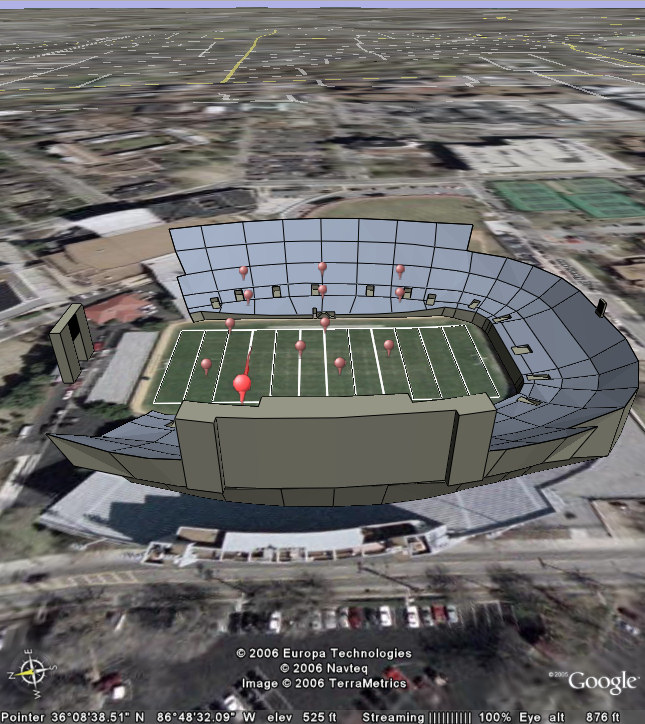Tracking of Radio Nodes
NEST | Countersniper | RIPS | Timesync | Documents | Download
Our radio interferometric technique can also be used to track mobile nodes utilizing stationery nodes at known positions. This technique was demonstrated at IPSN in 2006:
Check out the Google Earth-based user interface
We have showcased several exciting technologies in an integrated demonstration. The demo scenario is as follows: a plain cloth security guard walks around the stadium with a cell phone-integrated radiation detector. The person also carries an XBow XSM mote that we continuously track using an enhanced version of the radio interferometric positioning technique introduced at the ACM SenSys conference in 2005. There are 12 XSMs acting as infrastructure nodes deployed at known positions to enable tracking with ~1m accuracy throughout the stadium. When the radiation detector is in close proximity to a source, it sends an alarm using the mobile phone network. This causes a remote controlled camera to automatically zoom in on the position of the policeman. The large Jumbotron display in the stadium shows the video as well as the Google Earth-based user interface.
The tracking is done using a novel radio interferometric technique developed previously under the DARPA NEST program. The tracked node selects a neighbor and the pair acts as transmitters. They emit radio waves in the 400MHz band that have ~350Hz separation. All other infrastructure nodes measure the phase of the low frequency envelope signal that is the result of the two signals interfering. The relative phase offset of pairs of nodes provides information on the relative location of the four nodes involved. It is possible to determine the position of one node if at least four other nodes at known positions participate in the measurement. Additional nodes are used to provide better coverage of the large area and to compensate for errors introduced by RF multipath effects.
The security component (MultiMAC) provides group-based peer authentication for sensor nodes. We use the SkipJack implementation in TinySec as symmetric cipher. Each sensor stores a different set of keys in its ROM which is pre-defined by a key mapping scheme. Multiple message authentication code (MAC)s of every message are calculated in SkipJack, using the key set assigned to the sensor node. The receiver authenticates the message by recomputing MACs using its common keys with the sender.
The radiation detector is a small, battery-powered gamma detector connected to a mobile phone running a Java application reading the detector output. The output is sent nearly continuously over the phone's mobile data network to a server which checks the received gamma count for a threshold crossing. If an elevated gamma reading is seen, the server interfaces with the XSM system to determine the current location of the policeman and sends a control message to the camera system.
The camera system consists of a controller unit communicating with one or more cameras via a wireless network using the IEEE 1451 protocol. The system can be used to point the camera(s) on demand, based on alert conditions. The controller unit accepts position commands to slew, zoom, and focus a camera on a specific location. The locations are specified as coordinates (in any well-defined coordinate reference system) as well as "field of view," which determines the zooming degree of interest. Additionally, each camera's pan, tilt and zoom capabilities can be directly accessed and controlled over the network.
This integrated demonstration showcases important technologies and potential homeland security applications of sensor networks:
- highly accurate positioning and tracking using wireless sensor networks (ISIS-VU),
- sophisticated radiation detection capabilities (ORNL),
- secure sensor network architecture (ISIS-VU / TRUST),
- early example of the application of federated sensor networks (ISIS-VU and ORNL),
- highly accurate fine grained camera control (ORNL),
- modular micro-operating system for sensor networks (UC Berkeley),
- low-power mote design (UC Berkeley, Crossbow, OSU)
- Video clip of the report on Channel 4, the Nashville NBC affiliate
- Associated Press Report on ABC News
- Short Video Clip (1 min) in different formats
- Long Video Clip (4 min) in different formats
- Presentation
- 2005 Sensys Paper on radio interferometric positioning
- 2006 IPSN/SPOTS Paper on radio interferometric positioning
- Tracking: Branislav Kusy, Gyorgy Balogh, Miklos Maroti (ISIS-VU)
- Wireless Sensor Network Technology: Andras Nadas, Peter Volgyesi, Janos Sallai (ISIS-VU)
- Authentication: Yuan Xue, Taojun Wu (ISIS-VU)
- Radiation Detection: Johnny Tolliver, David Resseguie (ORNL)
- Camera Control: Morey Parang, Mark Gardner (ORNL)
Pictures:
The picture below shows the 3D model of the stadium with the 12 infrastructure motes along with the tracked mote in Google Earth:

The photo below shows the tracked person across the stadium:

The TV screen in the press room displays the live camera feed showing the tracked person:
